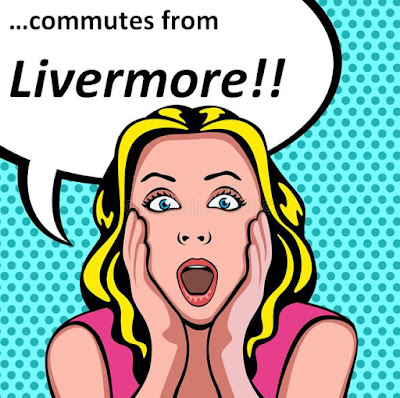This is part one of a series on commuting. This part focuses on commute distances. Part two looks at commute times. Link to that post is: https://meetingthetwain.blogspot.com/2018/07/commute-times.html
Truly urgent! and immediate! action must be taken - most likely involving big construction companies and large campaign contributions.
Where the heck is Livermore?
Google maps to the rescue!
 |
| "Livermore" is in the upper left. |
I looked at the commutes for the 20 largest metro areas and 6 others that are growing really fast. The data set includes 44 million workers. Including non-workers (kids, seniors, etc.) this is over 100 million residents. I always included the main centers of employment and I only looked at how many commuted in, regardless of where they lived.
Commute Distance Categories Average
How far people commute to work
The averages for the 26 US metro areas are shown below: (click graph to enlarge)
 |
| Almost 50% of workers commute less than 10 miles. Another 31% commute between 10 and 25 miles, 10% commute between 25 to 50 miles, 10% commute more than 50 miles. |
More on how to use the tool here: http://meetingthetwain.blogspot.com/2016/12/how-to-use-onthemap.html
Below is the summary graph for 21 of those metro areas. They are sorted by what percentage in each metro area fall into "commute less than 10 miles" ("< 10"). I have highlighted San Francisco, Los Angeles, and the entire 9-county SF Bay Area (including San Francisco) with arrows and special 'bars' so you can see to what extent they differ from other metro areas and from the 26 city averages. What is clear is that they aren't much different from the others. (click on graph to enlarge)
21 Metro Areas
Percentage of Each Metro Area by Commute Distance
One big surprise. Notice where LA (pink bar) is in the four categories. The city most famous for bad traffic seems to be about as close to average as one could reasonably expect.
"Hey, LA Dudes!!
We're Like, Totally Average!"
The second surprise was that I could see no numerical pattern at all. I expected to see some correlation with population. We saw in an earlier post that as the SF Bay Metro area grew it's commute boundaries expanded. We saw a significant increase in long commutes over time as population increased. That exploration is here: http://meetingthetwain.blogspot.com/2018/03/sf-bay-area-2-live-work-commute.html The graph for that is reproduced below:
Given this data I supposed that there would be a correlation between metro area population and commute times. If so, it doesn't show in this data. I calculated statistical "correlation coefficients" for population vs. each of the four commute categories. No coefficient was greater than 0.29 and two were essentially zero. Any correlation below 0.6 is too low to be meaningful.
In other words, each metro area's four commute-distance categories are not related to population but to local factors of culture, geography, and economics.
The third surprise was that in many aspects Los Angeles' commute patterns are "better" than those of San Francisco and the 9-county SF Bay Area. In fact, Los Angeles' commute patterns are remarkable for being unremarkable. The following graph show how those areas stack up in terms of commute distances.
SF Bay Area's Commutes Worse Than LA's
SF Bay Area has more super-commuters than LA
What you see in the above graph is that in the two less desirable categories, those commuting more than 25 miles and more than 50 miles, the SF Bay Area is worse (has more super-commuters) than the 26 metro area average. In the more desirable categories of less than 25 miles and less than 10 miles, the SF Bay area is worse (fewer commuters) than Los Angeles.
We can see this by looking at total Vehicle Miles Traveled per person below (click chart to enlarge):
LA and the SF Bay Area (image below) are equal in VMT for the three shorter commutes, "< 10", "10 - 25", and "25 - 50". Where they differ, and what makes LA 'better' than the SF Bay Area, is the "> 50" mile commutes - the "super commuters". (click image to enlarge)
 |
| More VMT due to Purple bar "greater than 50 mile" commutes. Super-commuters are more common in the SF Bay Area. |
 |
| Los Angeles with a 50 mile radius circle |
Now the SF Bay Area:
 |
| San Francisco with a 50 mile radius circle |
In short, less buildable land within 50 miles of employment centers = more super-commuters in the SF Bay area than in LA. As the earlier bar graph with those 21 cities showed, there are other metro areas with even more super-commuters - San Antonio, San Diego, Austin, Riverside County, and Houston. Still, the SF Bay Area is above average - mainly due to geography.
Summary: So now you know. The next time you hear "...commutes from Livermore!"
the proper response is a shrug and maybe a casual reply indicating your worldly sophistication such as...
"That's life in the big city, kiddo!" (shrug)









